A hunk of impossibly tender, juicy pork meat on the bone, all wrapped in crispy crackling skin, you say? Be still my beating heart! Called Schweinshaxe, this slow-roasted German Pork Knuckle comes with a richly-flavoured beer gravy.
Of the many things Germans have perfected, pork roast is right up there. And key to this meaty art is of course amazing crackling, something most recipes fall short on with Pork Knuckle … but we cracked the code!
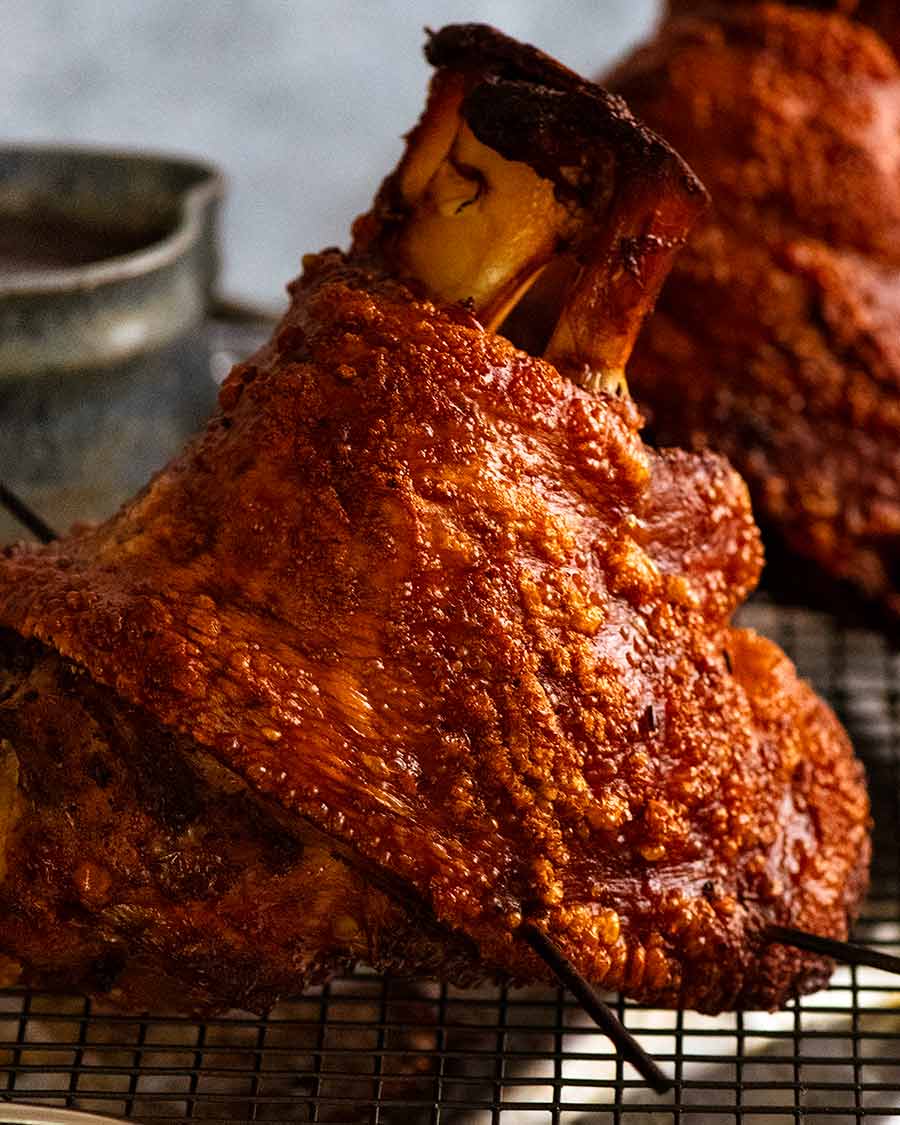
German Pork Knuckle (Schweinshaxe)
Pork Knuckle – sometimes called Pig Knuckle – is as Bavarian as Oktoberfest, lederhosen and BMW. Called Schweinshaxen, these mighty hunks of roasted pork hock are a fixture of pubs and beer halls in Munich and this part of Germany, as well as nearby Austria.
Always served in a puddle of dark and malty beer gravy, Pork Knuckle is loved by Germans for its juicy, lip-smackingly rich meat on the bone, all wrapped in a sheath of golden crackling that shatters under a knife.
Don’t let appearances fool you! Pork Knuckle might not win many beauty pageants (except maybe in the eyes of a Bavarian! 😂) but one taste is all it takes to fall head over heels for this German classic. And once you have, nothing else ever goes down quite as well with a giant stein of cold German beer!!
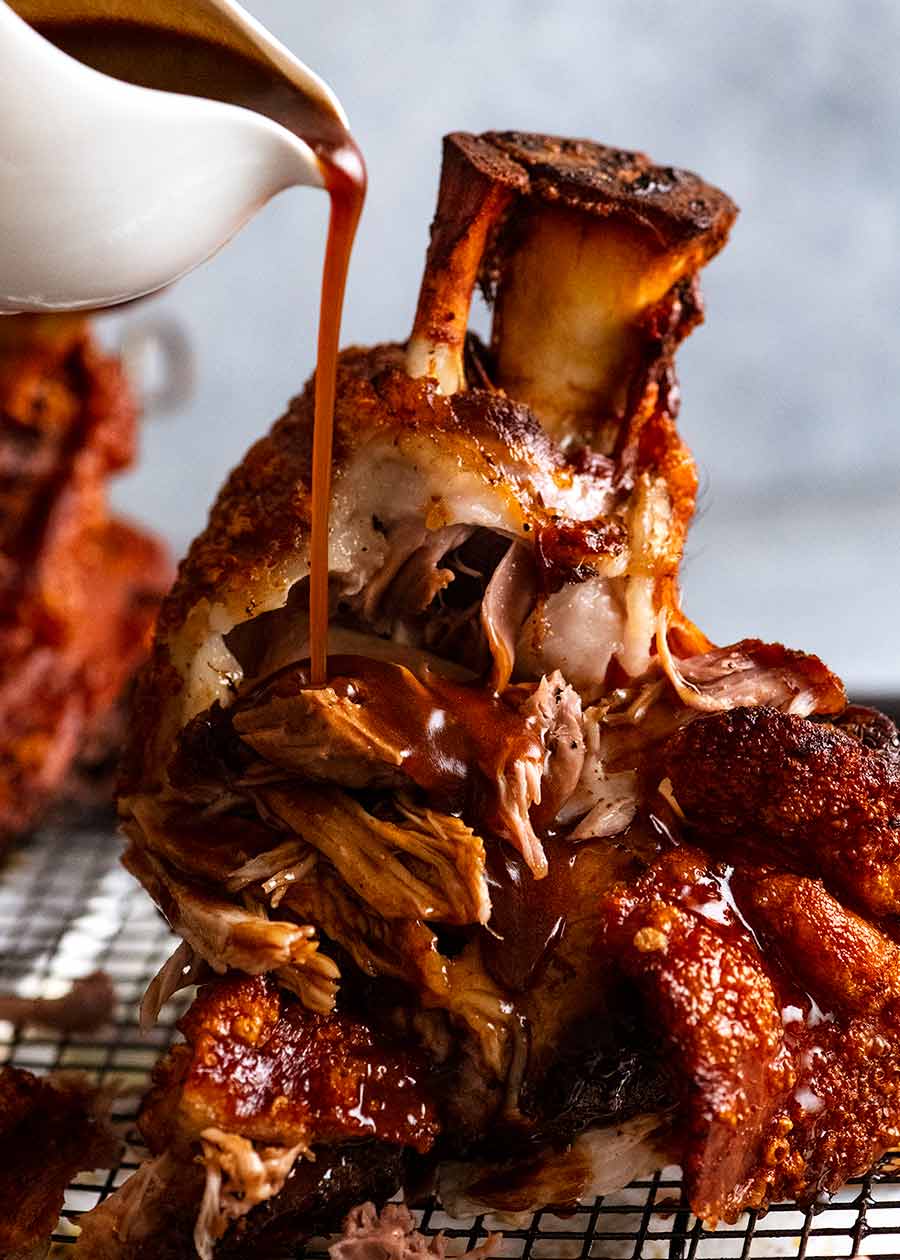
The challenge: How to make crispy skin on Pork Knuckle
While producing deliciously tender meat in German Pork Knuckle is straightforward enough, very rarely do you see a Pork Knuckle fully encased with really good crackling. I mean the properly bubbly skin, the stuff that shatters delightfully into a thousand porky shards under the teeth. Not the rock-hard and flat sort of crackling where it’s your teeth more likely to be shattering!
It’s the shape of the pork knuckle that makes it hard to get perfect crackling all over. Crackling is easy enough when the skin is level and flat as in pork belly and shoulder, due to even heat distribution. With Pork Knuckle, the skin is wrapped around the bone and oriented vertically.
This means two things. Firstly, due to height and thus temperature difference in the oven, the top and bottom skin areas of the knuckle are harder to cook evenly. Secondly, the skin shrinks as it roasts, causing creases and folds which never turn into good crackling.
So how do you get perfect crispy crackling for Pork Knuckle?
Here’s how:
Leave raw Pork Knuckle uncovered in the fridge overnight to let the skin dry out. This step I recommend for all my crispy crackling pork recipes such as this belly, also this belly and this shoulder;
Prick the skin all over using a small sharp knife or a pin. This is a proven technique I’ve used for Crispy Chinese Pork Belly to make the crackling bubbly-crispy instead of a hard and flat sheet;
High heat, always!;
Use skewers to keep the skin stretched and flat. This is the GAME CHANGING TIP! Without the skewers, the skin shrinks as it roasts. This creates crevices and folds, which leads to bad crackling. 😞
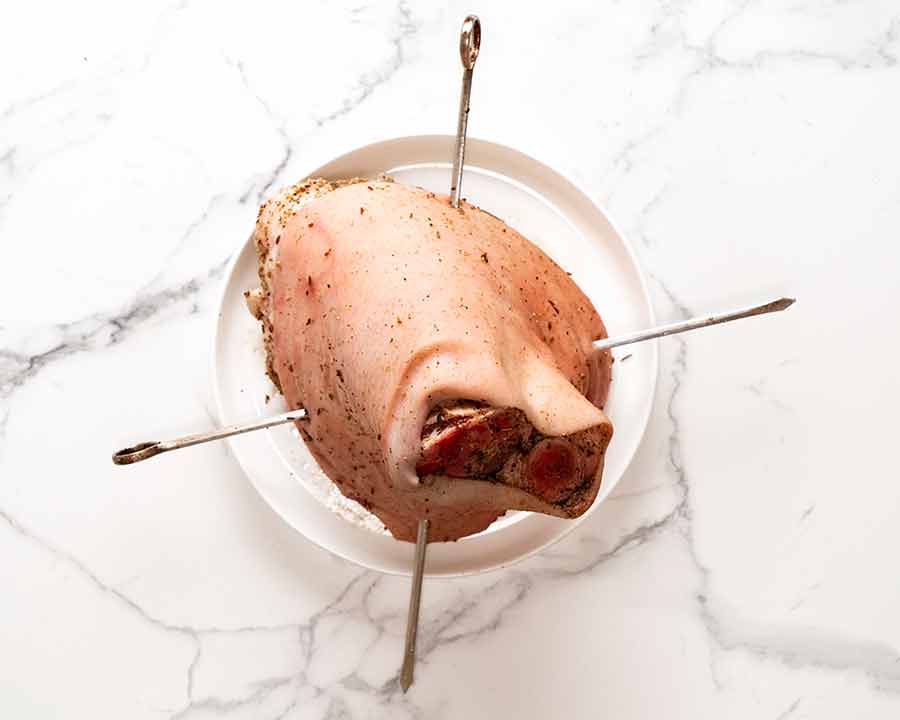
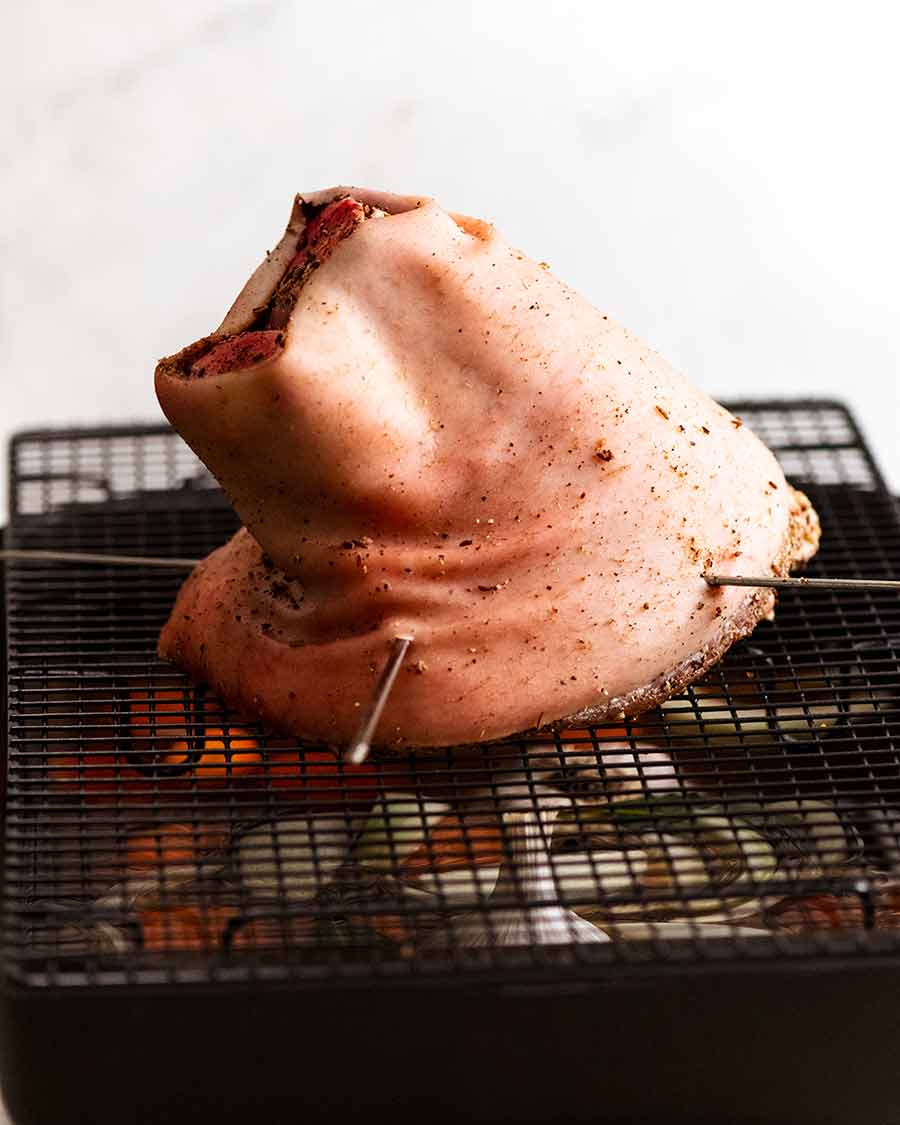
Ingredients for Crispy German Pork Knuckle
1. Pork knuckle
First up, you need to get your hands on a pork knuckle. Here is what it looks like:
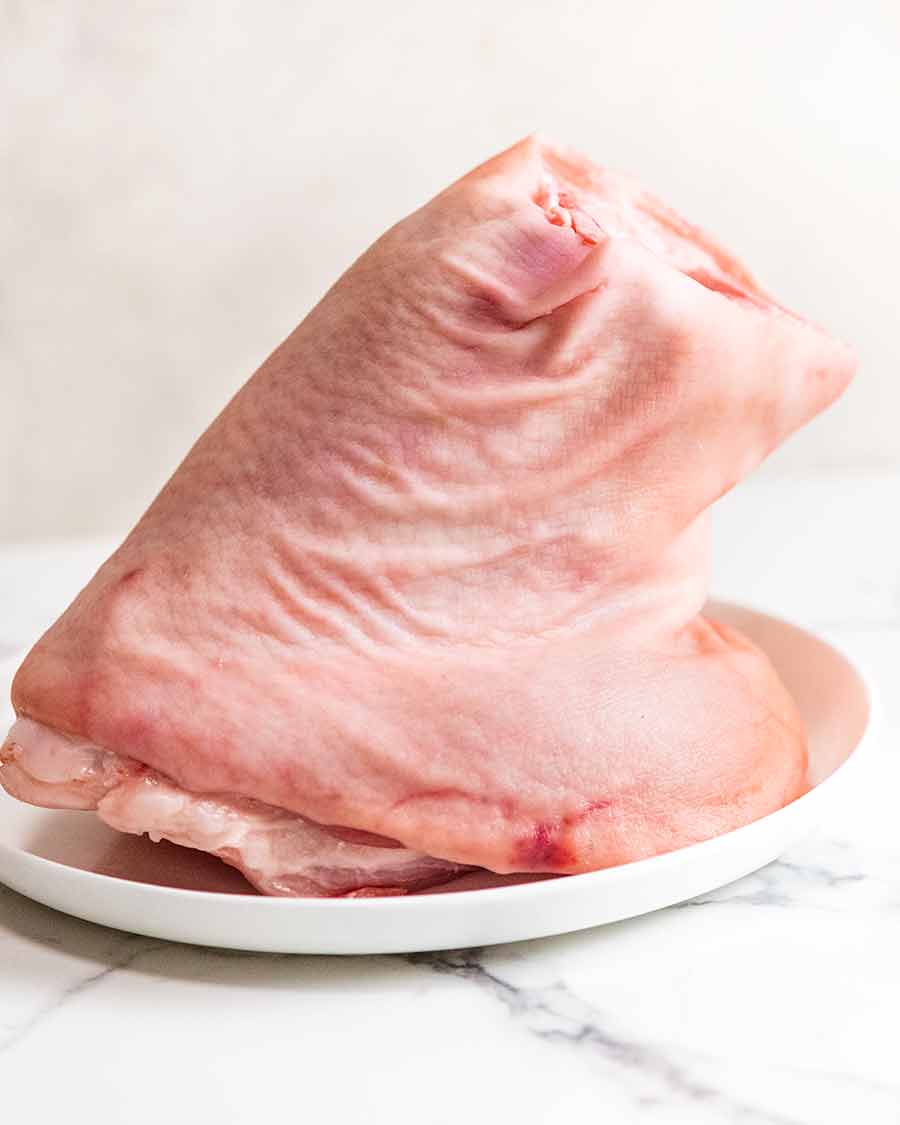
Firstly, pork knuckles are not pig’s trotters (feet)! Despite the name, it is actually the meaty upper part of the pig’s leg. Pork knuckle is variously known as pig knuckle, pork shanks, pork hock and ham hock (though this also refers to smoked or cured hocks). For German Pork Knuckle, we specifically need the rear leg knuckles / hocks because they are much bigger and meatier. Pork knuckles / hocks cut from the front legs of a pig are smaller and often smoked to make smoked ham hocks, for dishes like Pea & Ham Soup.
Note also that sometimes pork knuckles / hocks are sold brined (salted) as pickled hocks or ham hocks. Lightly brined knuckles may be suitable for this recipe, however I have not tested this. We also do not want smoked hocks. I recommend you stick to un-brined, raw pork knuckles / hocks.
One pork knuckle (around 1.2 – 1.3kg / 2.6 – 2.9lb) is enough to comfortably feed two. If it’s a particularly small knuckle, it will feed one very hungry eater!
Where to get pork knuckle – Here in Sydney, they are sold at some butchers though you usually need to ask for it, as they may have it out the back rather than in the counter display. However, I found it quite easy to get pork knuckle from Asian butchers. They may have it displayed or stored at the back. They are good value at around $8/kg ($4/lb)! Remember: Ask for rear leg hocks / knuckles. And show them the photo above! 😂
(Bit of food trivia for you: the reason why pork knuckles are easily found at Asian butchers is it’s a pork cut used in Asian cooking. In contrast, the pork knuckle is often part of the whole ham (leg) in Western cooking, hence why it’s not as widely available separately at Western butchers.)
2. Seasoning rub
Here’s what you need to prepare the pork for roasting:
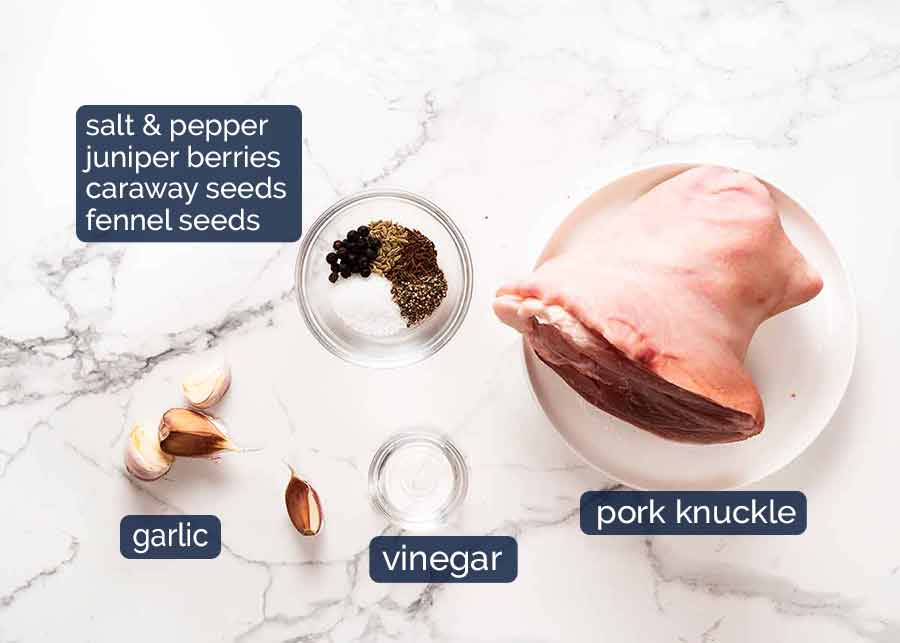
Juniper berries, caraway seeds and fennel – These are some traditional flavourings used when seasoning the Pork Knuckle. They are easy to find these days, though juniper berries are less common in mainstream grocery stores in Australia. Aside from spice shops, they are usually carried by delis and fresh produce stores with a good selection of herbs and spices (eg. Harris Farm);
Garlic – Because garlic is always welcome! These are cut into slivers and stuffed into small incisions made into the flesh of the pork; and
Vinegar – Vinegar is for brushing onto the flesh and skin of the pork to reduce strong pork odour that you can sometimes get roasting secondary pork cuts. It’s not a step you see with all pork recipes, but it’s worth doing as an insurance policy. It does not make the pork taste “vinegary” at all.
3. German beer gravy ingredients
A rich, dark, full-bodied gravy flavoured with beer is the traditional sauce served with Pork Knuckle . The base of the gravy is the pan juices remaining after roasting the pork knuckle. Here’s what you need to make it:
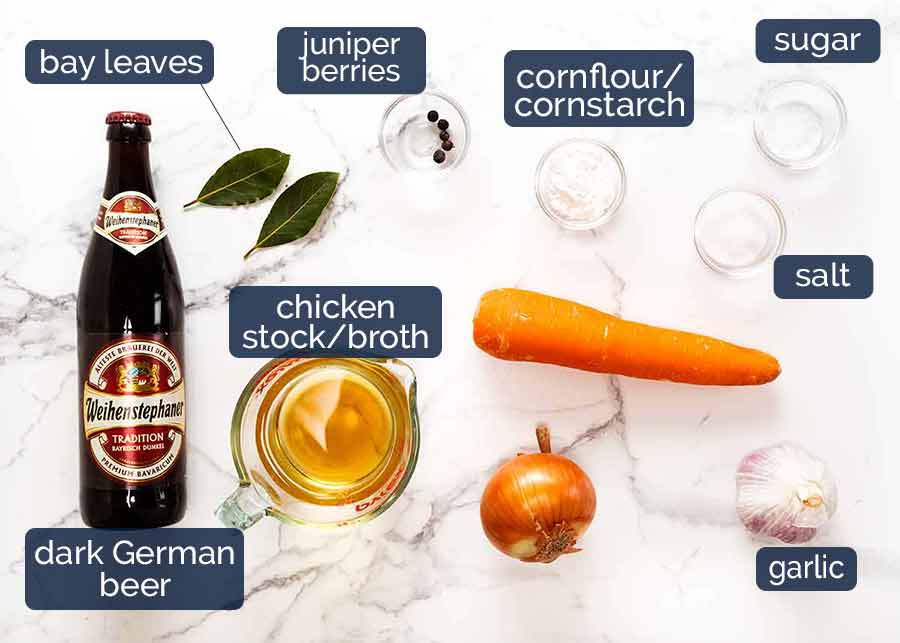
Dark German beer – The key flavouring for the gravy which also makes it a deep, dark brown colour. I used Weihenstephaner Tradition Bayrisch Dunkel which is a dark German beer (Bavarian, in fact!) sold at Dan Murphys in Australia .
If you can’t find German dark beer, any dark ale, porter or stout will do (even Guinness!). Just make sure it’s a proper dark beer else the gravy will lack richness, sweetness and colour. However, avoid stouts that are too heavy and bitter, as they can be overwhelming here.
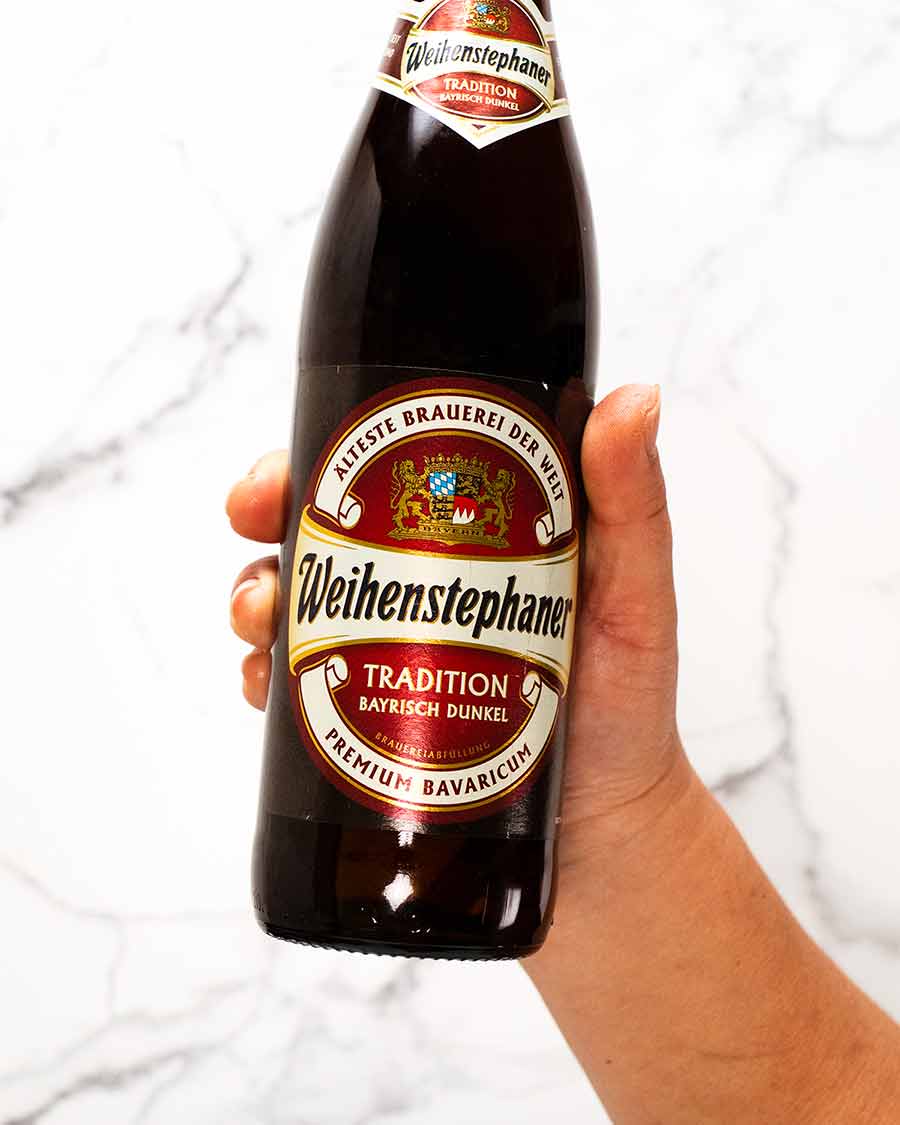
Bay leaves, carrot, onion and garlic – Typical ingredients used in homemade stocks for the flavour base, which is essentially what we’re making here!
Chicken stock – For extra savoury depth in the gravy. If you don’t have any, I am confident the gravy will still have enough flavour if you just used water instead;
Juniper berries – More of that fruity, spiky-tasting berry echoing the flavour in the pork rub;
Salt and sugar – Seasonings for the gravy; and
Cornflour / cornstarch – To thicken the beer gravy. This is fairly traditional in beer gravy for a couple of reasons. Firstly, it gives the gravy a clearer finish compared to flour, which makes gravies cloudy.
Secondly, we end up with a fair volume of pan liquid after the the pork is roasted since we are building a tasty stock under it as it roasts. This is different to the roasted meat pan drippings like with roast lamb, roast pork etc, which lacks much liquid initially. So we need a thickener we can just stir straight into the stock to make the gravy, rather than cooking off flour in the fats of pan drippings, and then adding liquids.
How to make Crispy German Pork Knuckle
This section is a bit lengthy. Fear not: it’s actually just information rather than an indication of effort! In all honesty, once you get to the actual doing part, you’ll realise it’s actually a very low-effort recipe. 🙂
Here’s a rundown of how I’ve broken this section up:
Preparing and seasoning the Pork Knuckle;
Slow-roasting;
Crisping up the crackling; and
Making the beer gravy.
Part 1: Preparation & seasoning
Firstly, preparing the pork and seasoning it!

Prick skin – Poke lots of small holes all over the Pork Knuckle’s skin using a small, sharp knife or even a pin (eg. safety pin, sewing pin). Around 100 or so. Really. Lots and lots! The more holes you prick, the more crackling “bubbles” you will end up with – and bubbles are good! No holes = flat and hard crackling = chipped teeth!
CAUTION: Don’t pierce the flesh! Take care not to pierce through the fat under the skin and into the flesh. Any holes that are too deep will cause the meat juices to bubble up through the hole and run down the skin. Everywhere the meat juices comes into contact with will not go crispy.

Brush flesh with vinegar – Brush or rub 1 tablespoon of the vinegar on the pork flesh, including inside any cracks or crevices, and under the skin where it meets the flesh (but do not peel skin back). See above in the ingredients section for why we apply vinegar.
Note at this stage we just apply to the flesh. The skin will be done later during the high heat roasting step when we are crisping up the crackling!
Stud with garlic: Make shallow incisions in the exposed pork flesh only with a small knife then stuff with the garlic slivers. This is to add flavour into the flesh;

Making the seasoning rub: Pound the rub ingredients in a mortar and pestle until it’s a coarse powder (or use a Nutribullet, spice grinder or similar);
Rub seasoning over pork: Rub pork skin with olive oil. Then rub the seasoning mix all over the pork – on the flesh, skin, and getting it into all the cracks and crevices.

Skewer skin (secret for crispy skin! ): Pull the skin down to stretch it taut so there’s no creases. Then thread through 2 metal skewers near the base of the knuckle in an “X” shape. Do this by piercing the skin on one side, forcing the skewer through the flesh and through the skin on the other side so it pierces the skin about 2cm / 0.8″ from the edge of the skin. Repeat with the other skewer, perpendicular to the first (to form a “X”), to hold the stretched skin in place.
TIPS:
– Position the skewers so they pass through as close to the bone as possible;
– Make the point at which you pierce the skin 2cm / 0.8″ from the bottom edge of the skin. If it’s too close to the edge, it might tear as it roasts;
– No metal skewers? Use wooden or bamboo skewers but soak them for 1 hour in water beforehand which will help stop them from burning in the oven. Also cut off most of the skewer excesses sticking out;Leave overnight: Place pork upright on a plate, then leave uncovered in the fridge overnight. The purpose of this is twofold. Firstly, to “marinate” the pork knuckle to get the seasoning flavours into the flesh as well as the salt. Secondly, to dry out the skin to ensure we get that awesome crispy crackling!
Part 2: Slow-roast
Seasoning and “marinating” done, now it’s slow-roasting time to make the flesh beautifully tender!

Prepare for roasting – Put all the beer gravy ingredients in a roasting pan that’s deep enough to hold more than ~1.5L (3 quarts) of liquid. Then set a rack over the pan and put the pork knuckle on top with the cut side face down.
This setup achieves two things. Firstly, the steam rising from the liquid keeps the underside flesh nice and moist without affecting the crispiness of the skin (the angle of the sloped knuckle skin is such that it doesn’t get directly hit with steam). And secondly, the meat juices drip down into the pan which adds lots of meaty flavour into the stock we’re building for the beer gravy. Win, win, win!
Slow-roast 2 hours 10 minutes – Roast for around 2 hours 10 minutes at 180°C / 350°F (160°C fan), rotating the tray halfway, or until the internal temperature in the thickest part reaches 85°C / 185°F.
Having a meat thermometer really helps here to achieve the ideal cook time for the flesh. Pork knuckle meat is actually not that fatty or uniformly rich with connective tissue, so if you cook it excessively it can begin to lose juiciness in parts.
It is still much more forgiving than lean pork cuts such as tenderloin, where dryness sets in quickly if you do cook it for longer than necessary. But it is not as forgiving as, for example, pork shoulder or pork belly, where you can go considerably over the required cook time and the flesh will still be juicy.
In short, it’s best to use a meat thermometer! I have a Thermapen – more on that cool gadget here.
What it looks like after the initial slow-roast, before crisping skin
When you pull the pork knuckle out of the oven after this initial slow-roast, the skin should still be soft and rubbery, but very dry. The skin needs to be soft at this stage in order for the pork crackling bubbles to form when we put it back into the oven at a very high temperature. If the skin is crispy at this stage, those lovely bubbles can’t form and it’s game over! 😩
This is what it should look like after the first cooking stage:
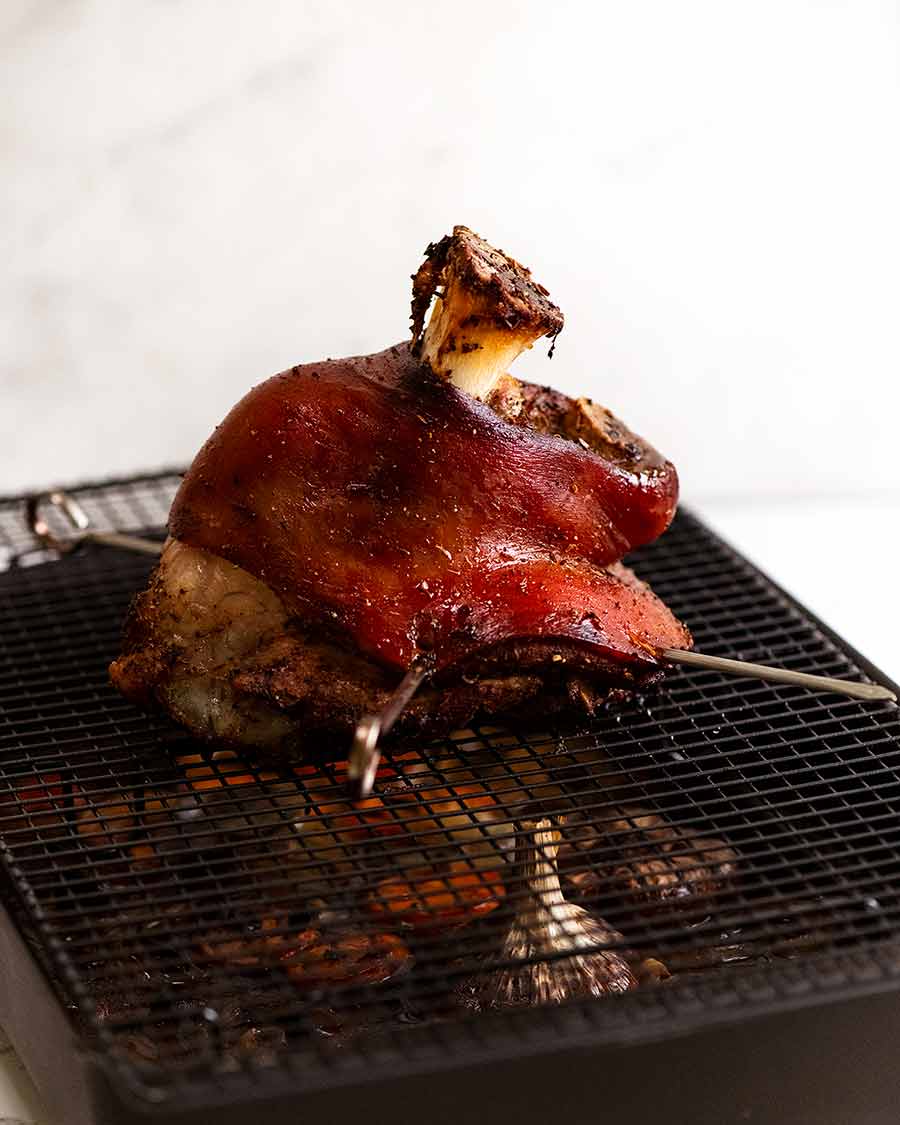
Part 3: Make that Crispy Pork Knuckle crackling!
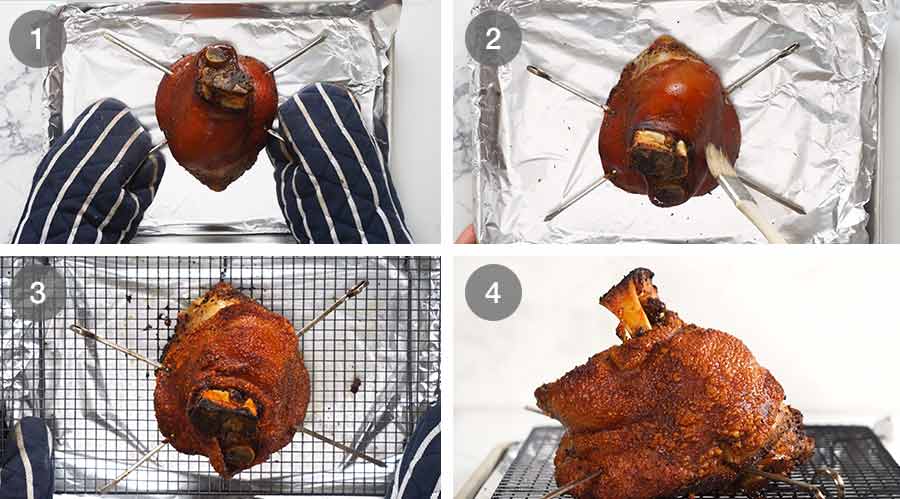
Crank up heat! – Transfer the knuckle to a separate tray, and increase the oven to 260°C / 500°F (240°C fan). Crackling needs a super-hot oven!
The liquid in the roasting pan at this stage should be reduced, and just needs to be thickened to make the Beer Gravy – see Part 4 below;
Brush skin with vinegar – Brush the skin with half the remaining 1 tbsp of vinegar. See above in ingredients section for the purpose of the vinegar.
Don’t worry! Brushing with vinegar doesn’t affect the crispiness of the skin. We only brush on a bit and the high heat of the oven evaporates it quickly;
Blast it! Put the knuckle in the oven for 30 minutes, rotating tray halfway and brushing with remaining vinegar at this point.
And now, swoon … The skin should be crispy all over, deep golden and mostly covered with beautiful, tiny bubbles. It will be near-perfect – as perfect I believe as you can get crackling with pork knuckle! The plain fact is that the shape of a pork knuckle means the crackling will never be quite as perfect as what you can achieve with a nice, flat piece of pork belly where the crackling can be made perfect from edge to edge.
But we get darn close, and I reckon better than anything I’ve seen out there!
Now rest the pork for 15 minutes to allow the juices in the meat to redistribute. If you skip this step, then the meat juices will just run everywhere when you start ripping* into the meat!
Don’t forget that jug of German beer gravy! See below for steps for how to make it.
* There is just no other way to describe how a pork knuckle should be eaten!
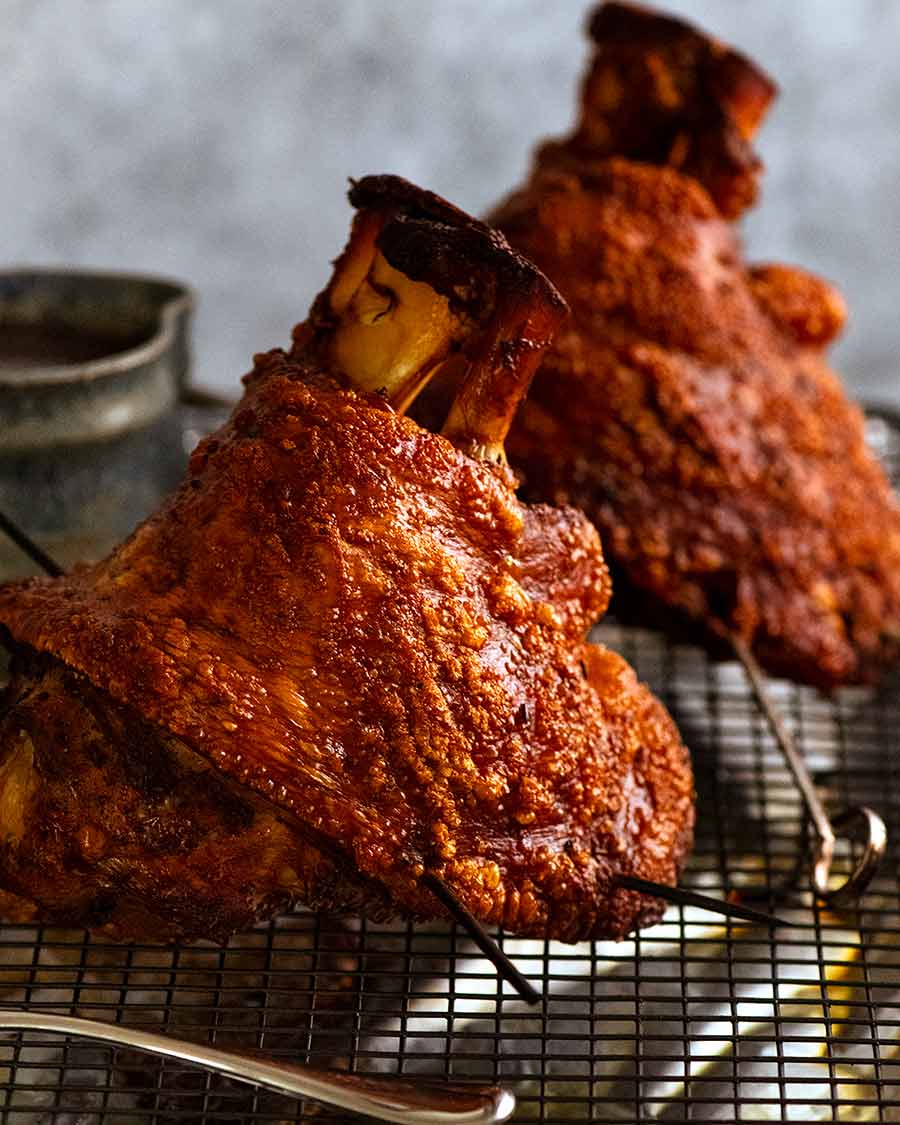
Part 4: German beer gravy
While the skin is crisping up in the oven into crackling perfection, make the beer gravy:

Strain – Strain roasting pan juices into a saucepan. The exact amount of liquid you end up with in the pan will be affected by things such as the accuracy of your oven, the size of the roasting pan and so on. But there’s no need to check for precise liquid quantity here, we can adjust it once the cornflour / cornstarch is added. Here’s how:
– If you’re short on liquid, the gravy will be too thick so we can just add water to increase the volume;
– If you have too much liquid, the gravy will be too thin so simmer the gravy for longer to reduce and concentrate;Aim for around 1.5 – 2 cups, but aim for gravy thickness as your guide for the right quantities. And taste, of course!
Thicken gravy with cornstarch – Once volume and concentration is adjusted (if necessary), bring the gravy stock to a simmer. Mix cornflour and water to make a slurry, then pour into gravy while stirring.
Then just simmer for 2 minutes until it becomes a thin syrup consistency. Beer gravy for Pork Knuckle is not supposed to be as thick as English-style gravy like you serve with roast pork or roast lamb. See above for adjusting thickness as required.
Pour gravy into a jug and serve alongside the pork knuckle. Or, plate it the traditional way by firstly pouring a big pool of gravy into the middle of a plate, then placing the knuckle grandly on top!
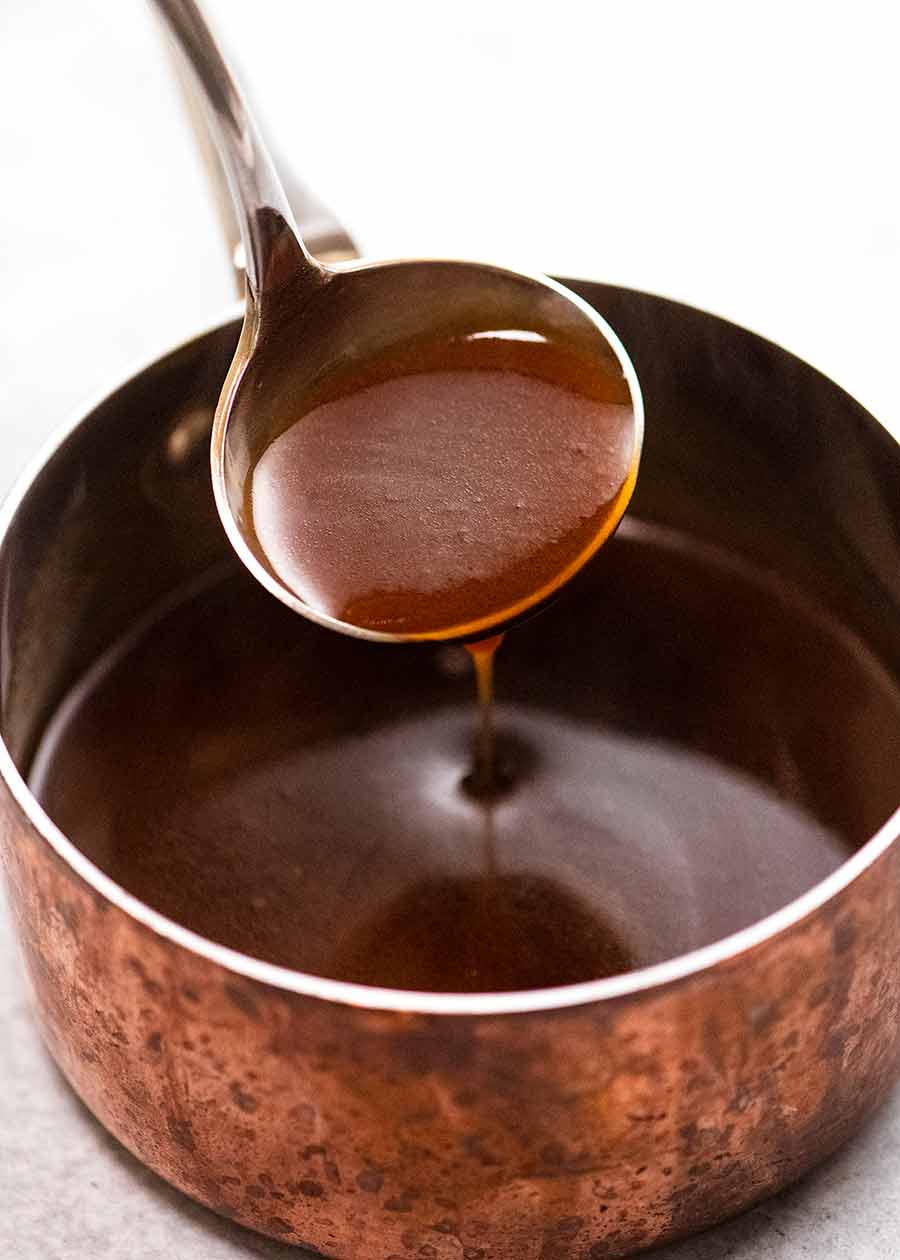
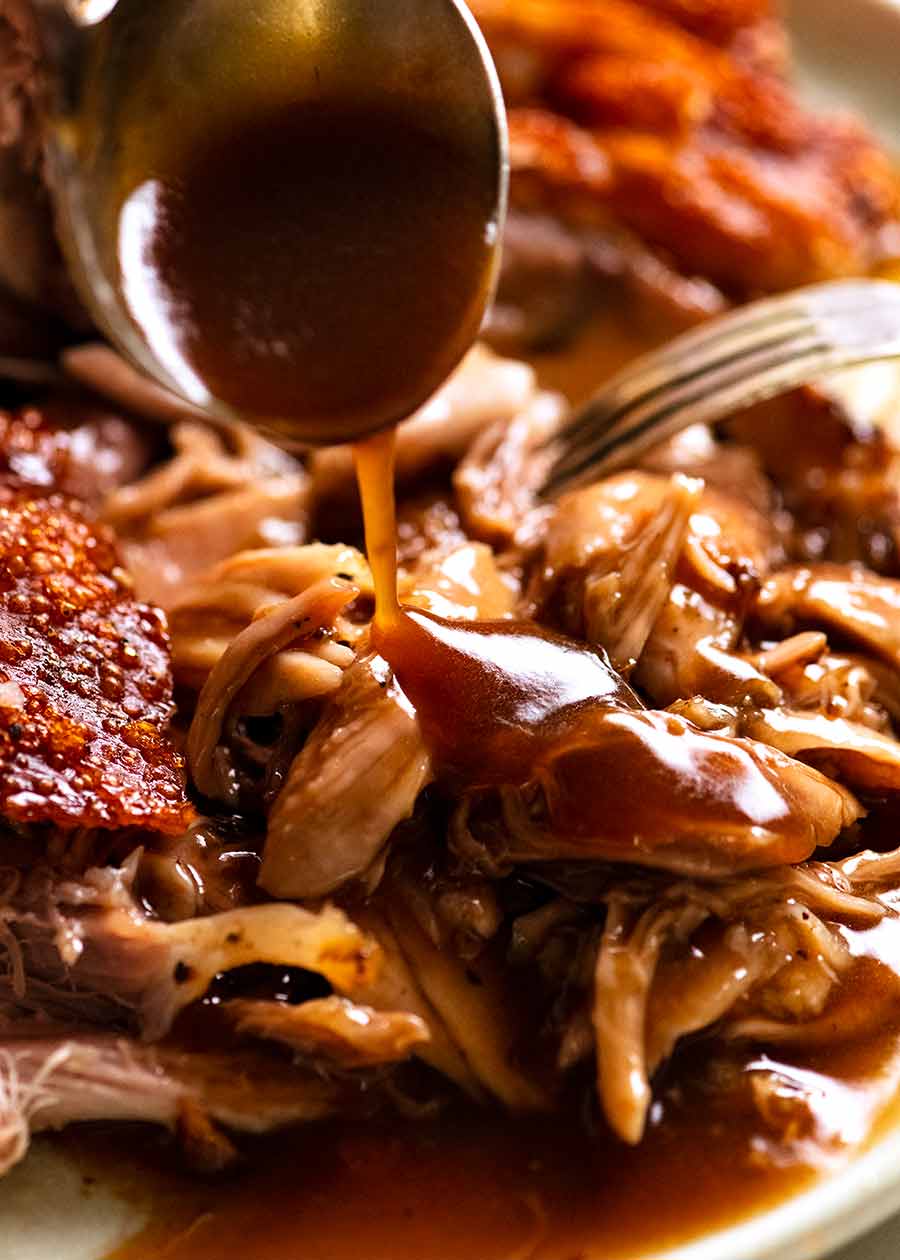
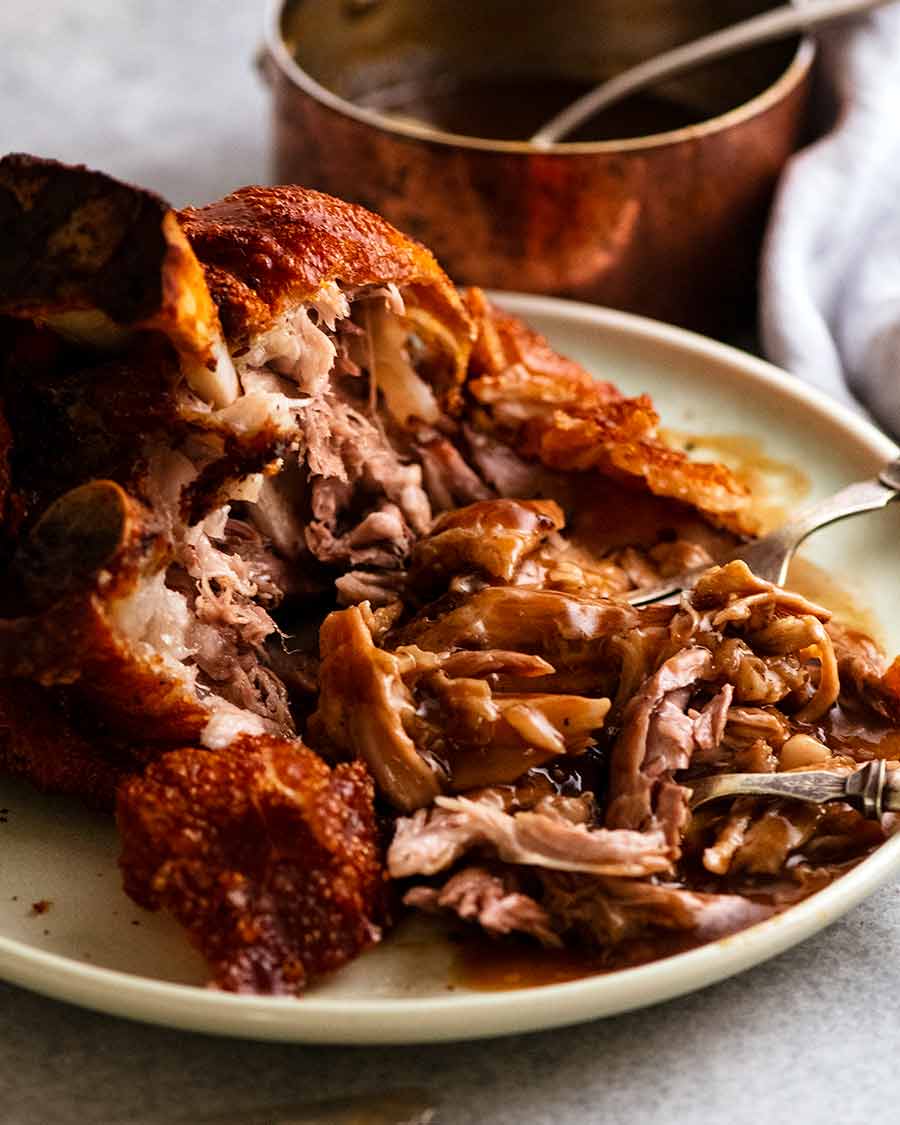
How and what to serve with German Pork Knuckle
Traditionally, Pork Knuckle is often served with a hefty German potato dumpling or two. The sticky balls make the perfect stodgy vehicle (in a good way!) for mopping up that delicious gravy! On the side, you might have some sauerkraut or a slaw-like cabbage salad (similar to this one, which would make a lovely side here).
Potato dumplings are beyond our scope for today, so later this week instead I will be sharing I’ve shared a German Potato Salad to go with the Pork Knuckle, as well as a refreshing sour cream and dill German Cucumber Salad that will be perfect to cut through all the sticky richness of the Pork Knuckle.
And for dessert? Well it’s just got to be everyone’s favourite cherry-laced German torte, Black Forest Cake hasn’t it? 😉 Watch this space!
With that, it’s over to you! Who can wait until Oktoberfest time to make this amazing roast?? Not me, that’s for sure!! – Nagi x
Watch how to make it
Hungry for more? Subscribe to my newsletter and follow along on Facebook, Pinterest and Instagram for all of the latest updates.
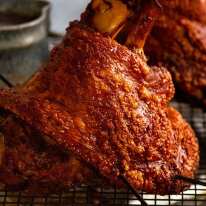
German Pork Knuckle (Schweinshaxe) – Slow Roasted with Crispy crackling!
Ingredients
- 1 x 1.25kg / 2.5lb pork knuckle (Note 1)
- 2 tbsp white vinegar (Note 2)
- 3 garlic cloves , cut into 4 – 6 slivers (Note 3)
Marinade Rub:
- 2 tsp salt , kosher / cooking salt NOT table salt (Note 4)
- 1 tsp black pepper
- 1 tsp juniper berries (Note 5)
- 1 tsp caraway seeds
- 1 tsp fennel seeds
Beer Gravy:
- 2 cups dark German beer (Note 6)
- 2 cups chicken stock / broth , low sodium
- 1 carrot , unpeeled, sliced 2cm / 0.8″ thick
- 1 onion , unpeeled, halved, cut into 1.25cm / 1/2″ thick slices
- 1 head garlic , cut in two halves horizontally
- 5 juniper berries (Note 5)
- 2 bay leaves , preferably fresh otherwise dried
Gravy thickening and seasoning:
- 2 tsp cornflour/cornstarch
- 1/2 cup water
- 1 tsp white sugar
- 1/4 – 1/2 tsp salt , kosher / cooking salt NOT table salt (Note 4)
Instructions
Preparation and seasoning:
- Prick skin: Poke lots of small holes all over the pork knuckle’s skin, using a small sharp knife or even a pin (eg. safety pin, sewing pin). Take care not to pierce through the fat into the flesh (Note 7).
- Vinegar: Brush (or rub) 1 tbsp of the vinegar on the pork flesh only, including inside cracks / crevices and meat under the skin where it meets the flesh (but do not peel skin back). Avoid getting vinegar on the skin.
- Stud with garlic: Make shallow incisions in the pork flesh (only) with a small knife then stuff with the garlic slivers.
- Seasoning rub: Pound the rub ingredients in a mortar and pestle until it's a coarse powder (or use a Nutribullet, spice grinder or similar).
- Rub seasoning on pork: Rub pork skin with olive oil. Then rub the seasoning mix all over the pork – on the flesh, skin, and getting into all the cracks and crevices.
- Skewer skin (secret for crispy skin! Note 8): Pull the skin down to stretch it tight so there's no creases. Then thread through 2 metal skewers in a "X" formation near the base of the knuckle. Pierce through skin 2cm / 0.8" from the base of the pork knuckle to hold the stretched skin in place.
- "Marinate" overnight: Place pork standing on a plate, then leave uncovered in the fridge overnight (Note 9).
Slow-roasting:
- Preheat oven to 180°C / 350°F (160°C fan).
- Beer gravy: Put all beer gravy ingredients in a roasting pan (deep enough to hold all liquids and vegetables).
- Rack on pan: Place a rack over the pan. Place pork knuckle on rack, sitting upright. (Note 10)
- Slow roast: Roast for 2 hours 10 minutes, rotating tray half way. (If the liquid in the pan is getting too low and in danger of drying out, top with 1/2 cup of water at a time.) Roast until the internal temperature in the thickest part of meat reaches 85°C / 185°F.
Make crispy Pork Knuckle crackling!
- Remove knuckle from oven, transfer knuckle to a tray.
- Increase oven: Increase oven to 260°C / 500°F (240°C fan) (Note 11)
- Brush skin with vinegar: Brush skin with 1/2 the remaining 1 tbsp of vinegar. Place in oven for 30 minutes, rotating tray halfway and brushing with remaining vinegar.
- Skin should be crispy, dip golden and mostly bubbly.
- Rest: Rest 15 minutes before serving with German Beer Gravy!
German beer gravy:
- Strain liquid: Strain roasting pan juices into a saucepan. Ideally you should have around 1.5 – 2 cups.
- Thicken: Bring liquid to a simmer. Mix cornflour and water, then pour into liquid while stirring. Add sugar and salt to taste.
- Simmer: Simmer for 2 minutes or until it becomes a thin syrup consistency (German beer gravy should not be as thick as normal gravy, but quite runny). If it's too thick, add a touch of water. Too thin, simmer to reduce – it will thicken. Serve with pork knuckle!
Recipe Notes:
Nutrition Information:
Life of Dozer
He can’t read…🤷🏻♀️



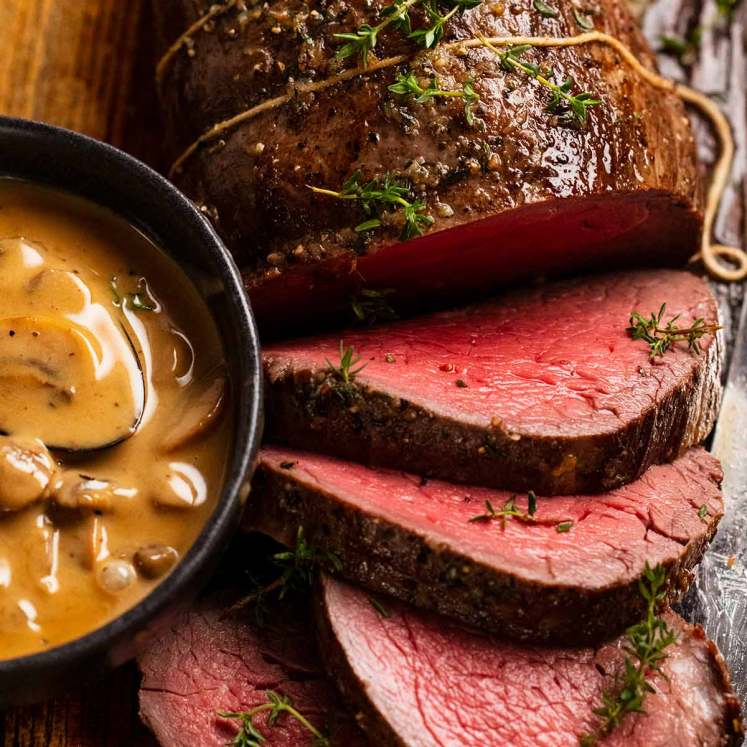
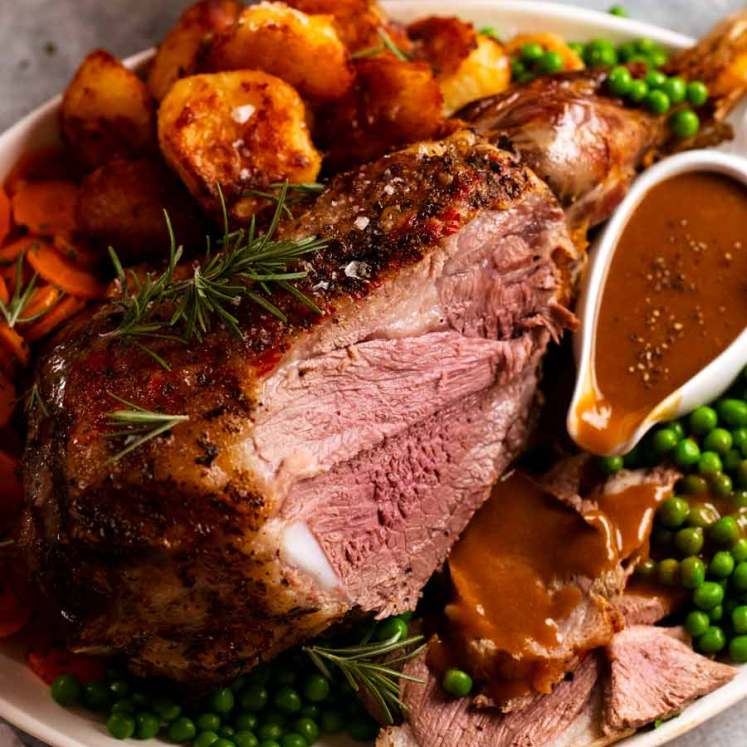
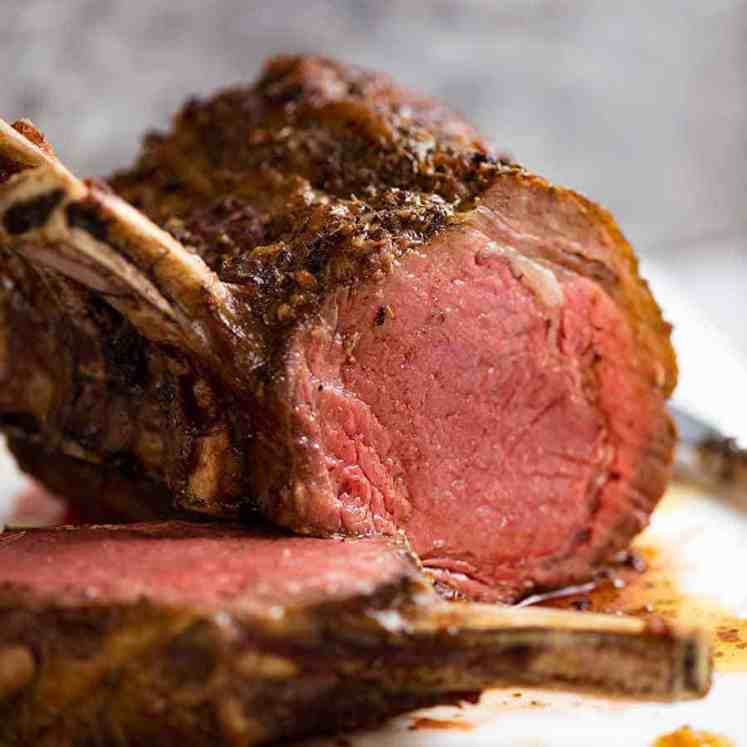
Hi, I noted the vinegar is to be avoided for the skin as mentioned in the instruction section. However, the vinegar is used for the skin as mentioned in the recipe notes. So, may I confirm should we avoid the vinegar at the skin?
My son loved this and said it was better than the German Club..I am only an average cook so was delighted with the result. Thank you.,
Any tips to reheat the leftovers and make the skin crunchy again?
It came out great!….The bubbling happened and the steaming worked. I had friends over and we all loved it!
Has anyone tried making them ahead, putting in the fridge, and saving the final crisp step for serving right before?
I have high hopes for this recipe, it is currently in the fridge getting ready to be roasted tomorrow. I just wanted to add that I very much WISH that I had put the skewers in BEFORE oiling, inserting the garlic and covering with seasoning. I struggled getting the skewers in and doing it on an oiled pork hock made it that much more difficult.
I made this and it turned out delicious! The best eisbein I have ever had, hands down, definitely saving this recipe.. thank you so much for sharing! I was in a rush so I didn’t even leave it in the fridge overnight, and still turned out amazing
Just wanna let you know I’m so happy I found you, I Have never seen a recipe that explains things in so much detail & Believe me which I am so thrilled about I have been looking This recipe-for years this looks absolutely delicious over-the-top and I can’t wait to try it thank you so much and I’m signing up for newsletters and probably anything else I can. you are a very good Instructor and no doubt a very talented Chef. Will be following you. Linda
This recipe is amazing!! Thank you, I dried the pork knuckle out for 2 days in my fridge and then followed your recipe and it was awesome. The pork turned out so moist and soft. Even the crackle turned out perfect. And that beer gravy blew our minds!!! Thank you!!
Woo hoo!!! I’m so glad you liked it Adriana! N x
The best method for pricking the skin is utilizing like an o-ring pick. You can get them from any hardware store most likely. Pins are too hard to hold to penetrate the pork skin as it’s rather tough. Knife makes it too easy to pierce into the meat.
Thank you so much for suggesting an O-ring. I tried every utensil in the house and garage for getting through that skin. O-ring it is! Thank you!
Thanks for that tip Peetah! Very helpful!! N x
I am German and sorry not how we cook or eat Schweinshaxe. I like your recipes but this one is a no go
I was wondering how a cross hatch pattern on the skin would work like on a Krustenbraten? Seems like the same idea only bigger chunks or crispiness!
I’m trying this with a boneless pork shoulder tonight. I have used a knuckle previously and it was so good albeit a bit small. Think I’ll lay it flat to get an even crackle with the ol foil ball trick from your other recipes.
Sounds yummy Gary! Good luck! N x
Hi I am having trouble finding Juniper berries in Cyprus can I substitute with something else. Thanks
Oh my giddy Aunt….this was delish, hubbie was worrying it was gonna dry out with the cooking time, I fed him vino and he kept quiet! Compliments to you..and thanks, will totally make again and again…happy full belly’s here 🙂
Great tip for keeping the audience quiet, Jennifer 🍷😂 !!! N x
This is a good one.
Hi Nagi.
I have a huge knuckle and am planning to cook it at 120 c for about 5 hrs. Would this work. I like your Idea of the skewers to hold the skin in place.
Looking forward to you answer.
Have a great day thanks. Chris
What size is the pork knuckle Chris? Weight? Also the key to good crackling and texture is the hot oven so I don’t think that 120 would necessarily work well. You need to prepare the skin, dry it out and follow all the steps in the recipe for a good result. N x
I’ve not had much success with bamboo skewers – they just break. I want to get the metal ones. I think they will work much better.
I cannot get pork knuckle here where I live so I used 7.5 lbs pork picnic shoulder instead. 2.5hrs to cook and 30 mins to crisp the skin. Your recipe works wonders! Thank you very much for the detailed instructions!
Hi Nagi , can I make this ahead of time
I can’t guarantee that the crackling will stay crispy after being in the fridge! N x
I’ve just put this in the fridge overnight. So nervous! Think crispy thoughts for tomorrow!
Will do! N x
It worked, SO crispy. The skin came away from the skewers so it still rolled up. Could I have done something different?